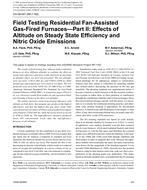Description
This paper is based on findings resulting from ASHRAE Research Project RP-1182.
The results of field testing four induced draft residential furnaces at three different altitudes to evaluate the effect on steady state efficiency and nitric oxide emissions of operating at altitudes above sea level are presented. The test altitudes were sea level, 2250 ft (685 m), and 6700 ft (2040 m). Both natural gas and propane gas were used as test fuels. The test protocols used were from ANSI Z21.47-2001/CSA 2.3-2001 American National Standard/CSA Standard for Gas-Fired Central Furnaces (ANSI 2001). A companion paper (Fleck et al. n.d.) discusses results from studies on safe operation limits and derating schemes at the three test altitudes.
The results showed a trend of increasing efficiency with altitude on both fuels, that propane gas produced the highest efficiencies, and that the highest flue gas nitric oxide (NO) concentration levels (mass of NO per unit of useful heat output) were found at 2250 ft (685 m), while the lowest levels occurred at 6700 ft (2040 m). The high-efficiency furnaces produced lower NO concentration levels than the mid-efficiency furnaces at all altitudes.
Units: Dual
Citation: ASHRAE Transactions, vol. 115, pt. 1, Chicago 2009
Product Details
- Published:
- 2009
- Number of Pages:
- 19
- File Size:
- 1 file , 5.6 MB
- Product Code(s):
- D-CH-09-047




